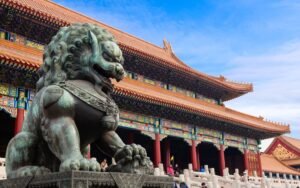In the study of the Chinese language, especially when dealing with complex topics like economics, understanding synonyms and their nuanced differences becomes essential. Two commonly used words that often appear in discussions of economic growth and prosperity are “繁荣” (fánróng) and “兴盛” (xīngshèng). At first glance, both words may seem to express similar ideas of wealth, success, and flourishing. However, these terms are used in different contexts and emphasize distinct aspects of growth and prosperity.
In this article, we will explore the subtle differences between “繁荣” and “兴盛,” their usage in economic discourse, and how these words reflect varying aspects of economic success. We will also provide real-life examples to illustrate how these words are applied, offering insights into their practical usage. If you are learning Chinese and are interested in deepening your understanding of such synonyms, I highly recommend checking out the flexible Chinese courses offered by LC Chinese School in Oslo. These courses are designed to enhance your linguistic precision and cultural comprehension.
Table of Contents
Toggle1. The Basic Meanings of “繁荣” and “兴盛”
1.1 “繁荣” (Fánróng)
“繁荣” is a term commonly used to describe the active growth and success of an economy or society. It implies a flourishing state where businesses, industries, and the market are all functioning optimally. The word “繁” suggests abundance or multiplicity, while “荣” conveys the idea of honor or prosperity. Together, “繁荣” indicates a prosperous environment with bustling activity, high productivity, and economic dynamism.
Example:
这个国家的经济已经进入了繁荣的阶段。
Pinyin: Zhège guójiā de jīngjì yǐjīng jìnrù le fánróng de jiēduàn.
Translation: The economy of this country has entered a phase of prosperity.
In this context, “繁荣” highlights the dynamic and vibrant growth of the economy, characterized by increased industrial output, consumer spending, and market expansion.
1.2 “兴盛” (Xīngshèng)
On the other hand, “兴盛” focuses more on the strength and vitality of something over time, whether it be a culture, industry, or even a nation. The word “兴” means to rise or flourish, and “盛” refers to grandness or greatness. “兴盛” often describes the growth or flourishing of something with a deep historical or cultural significance, implying that this success is not merely fleeting but sustained over time.
Example:
这个城市的纺织工业曾经非常兴盛。
Pinyin: Zhège chéngshì de fǎngzhī gōngyè céngjīng fēicháng xīngshèng.
Translation: The textile industry in this city was once very prosperous.
In this case, “兴盛” is used to emphasize the rise and prominence of the textile industry, but it also implies a certain cultural or historical context in which this industry was of great importance.
2. The Usage of “繁荣” in Economic Contexts
2.1 “繁荣” in Describing Economic Growth
“繁荣” is frequently used in economic discourse to describe rapid growth in industries, markets, or economies. This word conveys the idea of a healthy and vibrant economy where various sectors—such as manufacturing, technology, or real estate—are all experiencing significant growth. In discussions about GDP growth, increased foreign investments, or market expansion, “繁荣” is the preferred term.
Example:
在政府的支持下,这个地区的经济变得非常繁荣。
Pinyin: Zài zhèngfǔ de zhīchí xià, zhège dìqū de jīngjì biàn dé fēicháng fánróng.
Translation: With the support of the government, the economy in this region has become very prosperous.
Here, “繁荣” illustrates a rapidly growing economy, supported by government policies, foreign investment, and technological innovation. It implies that all parts of the economy are benefiting from this growth.
2.2 “繁荣” in Relation to Business and Markets
In addition to describing economies, “繁荣” is also widely used to describe specific markets or industries that are experiencing growth. For instance, you might hear people say that the tech industry is “繁荣,” meaning it is booming, with new innovations, startups, and increasing consumer demand all contributing to its success.
Example:
随着科技创新的加速,全球的电子商务市场越来越繁荣。
Pinyin: Suízhe kējì chuàngxīn de jiāsù, quánqiú de diànzǐ shāngwù shìchǎng yuèláiyuè fánróng.
Translation: With the acceleration of technological innovation, the global e-commerce market is becoming increasingly prosperous.
This example demonstrates how “繁荣” can be applied to a specific industry—in this case, e-commerce. It reflects a situation where there is rapid growth, high demand, and abundant opportunities for businesses to thrive.
3. The Usage of “兴盛” in Economic Contexts
3.1 “兴盛” in Describing Long-Term Success
“兴盛” often appears in economic discussions when the focus is on long-term sustainability and historical success rather than short-term gains. It implies a flourishing state that has endured or is expected to endure, often in a cultural or historical context. For example, when discussing ancient trade routes like the Silk Road or the lasting success of a long-established industry, “兴盛” is the term used.
Example:
中国的丝绸贸易在历史上非常兴盛。
Pinyin: Zhōngguó de sīchóu màoyì zài lìshǐ shàng fēicháng xīngshèng.
Translation: China’s silk trade was very prosperous in history.
Here, “兴盛” reflects the sustained and historically significant success of China’s silk trade, a business that flourished for centuries. This usage shows how “兴盛” is often associated with industries or economic activities that are deeply embedded in a culture or historical period.
3.2 “兴盛” in Relation to Cultural or Heritage Industries
“兴盛” is also used to describe industries or sectors that are tied to cultural heritage or long-standing traditions. For example, if a particular craft or art form has thrived for many generations and remains strong, we use “兴盛” to indicate that it has sustained its vitality over time.
Example:
日本的手工艺品市场在国内外都非常兴盛。
Pinyin: Rìběn de shǒugōng yìpǐn shìchǎng zài guónèiwài dōu fēicháng xīngshèng.
Translation: Japan’s handicraft market is very prosperous both domestically and internationally.
In this case, “兴盛” highlights the enduring strength of Japan’s handicraft market, which is rooted in cultural tradition. This word suggests that the industry is not only profitable but also deeply significant in the cultural context.
4. The Differences Between “繁荣” and “兴盛”
Now that we’ve explored the individual meanings and usage of “繁荣” and “兴盛,” let’s look at the key differences between these two words:
4.1 Contextual Differences
- 繁荣 is generally used to describe rapid growth and current dynamism, especially in markets and industries. It often appears in conversations about modern economic trends, government policies, and innovations driving growth.
- 兴盛, on the other hand, is more suited to describing long-term success and historical flourishing. It’s particularly used in discussions where the success of an industry or region is deeply rooted in tradition or has endured through generations.
4.2 Temporal Implications
- 繁荣 tends to focus on the present or near future, capturing moments of active, bustling growth.
- 兴盛 typically implies that the growth is sustained over a longer period, often looking back at historical contexts or forward to a long-term future.
4.3 Emotional and Cultural Connotations
- 繁荣 often comes with a sense of vibrancy and activity, suggesting a fast-paced, booming economy.
- 兴盛 conveys a sense of grandeur and continuity, often with an emotional connection to cultural or historical significance.
5. Practical Examples of “繁荣” and “兴盛” in Business and Economics
5.1 Technology Sector
- “繁荣” Example:
随着人工智能技术的快速发展,全球科技行业变得越来越繁荣。
Pinyin: Suízhe réngōng zhìnéng jìshù de kuàisù fāzhǎn, quánqiú kējì hángyè biàn dé yuèláiyuè fánróng.
Translation: With the rapid development of artificial intelligence technology, the global tech industry is becoming increasingly prosperous. - “兴盛” Example:
这家公司依靠长久以来的技术积累,电子产品市场始终兴盛。
Pinyin: Zhè jiā gōngsī yīkào chángjiǔ yǐlái de jìshù jīlěi, diànzǐ chǎnpǐn shìchǎng shǐzhōng xīngshèng.
Translation: This company, relying on its long-standing technological accumulation, has seen sustained prosperity in the electronics market.
5.2 Tourism Industry
- “繁荣” Example:
随着旅游基础设施的不断改善,这个国家的旅游业变得非常繁荣。
Pinyin: Suízhe lǚyóu jīchǔ shèshī de búduàn gǎishàn, zhège guójiā de lǚyóu yè biàn dé fēicháng fánróng.
Translation: With continuous improvements in tourism infrastructure, the tourism industry in this country has become very prosperous. - “兴盛” Example:
历史悠久的文化遗产使得这个地区的旅游业兴盛不衰。
Pinyin: Lìshǐ yōujiǔ de wénhuà yíchǎn shǐde zhège dìqū de lǚyóu yè xīngshèng bù shuāi.
Translation: The ancient cultural heritage has kept the tourism industry in this region flourishing.
6. Enhancing Your Chinese Vocabulary Through Flexible Courses
Understanding synonyms such as “繁荣” and “兴盛” is crucial for mastering advanced Chinese, particularly when discussing complex subjects like economics. These words may seem interchangeable, but their nuanced differences can affect the precision and emotional impact of your communication. For learners aiming to improve their Chinese skills, particularly in specialized fields like business or economics, it’s essential to dive deeper into such distinctions.
If you want to improve your Chinese proficiency and gain insights into the subtle differences between words like “繁荣” and “兴盛,” I recommend joining LC Chinese School’s flexible Chinese courses in Oslo. These courses are tailored to meet the needs of both beginners and advanced learners, offering lessons that cover various topics, from everyday conversations to professional language in business contexts.
Conclusion
The distinction between “繁荣” and “兴盛” highlights how nuanced the Chinese language can be, especially in fields like economics. While both words describe growth and success, “繁荣” captures the bustling, dynamic aspects of modern economic activity, whereas “兴盛” emphasizes long-term vitality and historical flourishing. Understanding these differences allows us to communicate more effectively and precisely, whether we are discussing booming tech industries or culturally significant trade practices.
For those learning Chinese, mastering such vocabulary is key to fluency and cultural competence. Whether you are preparing for professional communication or simply expanding your language skills, LC Chinese School in Oslo offers courses designed to enhance your vocabulary and comprehension in real-world contexts.







